Raised garden beds DIY projects can make your outdoor space look better and work better. They add elegance and function to your garden. With them, you can make a garden that’s not just beautiful but also full of life.
Raised garden beds are great for growing plants. They make gardening easy and efficient. By adding raised beds to your yard, you can grow your favorite plants and make your yard look good too.
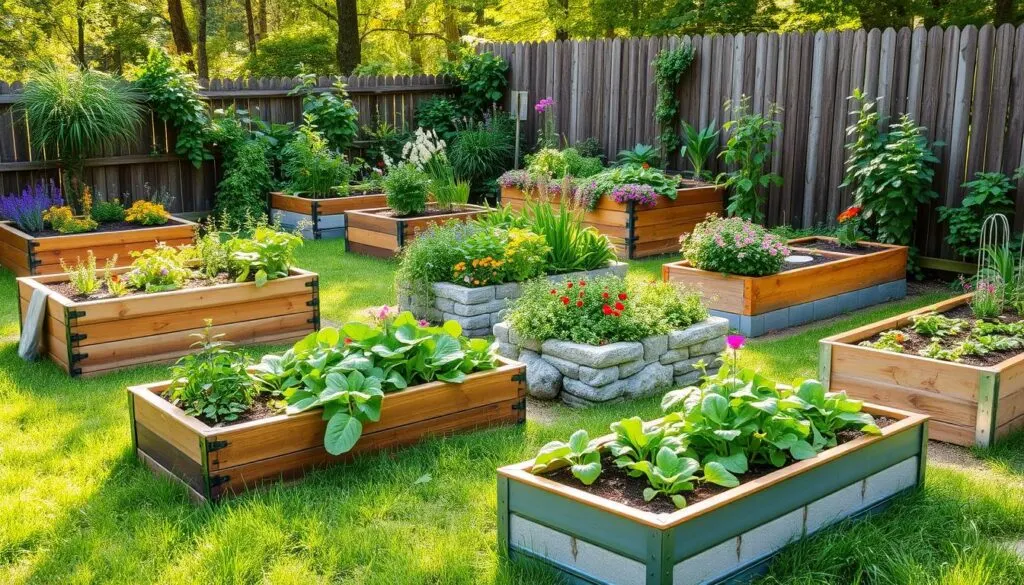
In this guide, we’ll talk about the good things about raised garden beds. We’ll cover how to build and take care of them. We’ll give you the info and ideas you need to create your dream garden.
Key Takeaways
- Raised garden beds DIY can enhance your outdoor landscaping and garden design
- Raised garden beds offer improved drainage and soil control
- With raised garden beds, you can extend your growing season and enjoy a longer harvest
- Raised garden beds DIY projects can be customized to fit your garden design and outdoor landscaping needs
- Raised garden beds require regular maintenance to ensure optimal growth and productivity
- Raised garden beds can be used to grow a variety of plants, including vegetables, fruits, and flowers
Benefits of Raised Garden Beds for Home Gardeners
Raised garden beds are great for home gardeners. They help control soil quality, leading to better drainage and aeration. This makes plants grow healthier and reduces garden upkeep.
Some key benefits of raised garden beds include:
- Improved soil structure, which enables better water penetration and retention
- Reduced soil compaction, allowing roots to grow deeper and stronger
- Warmer soil temperatures, extending the growing season and enabling gardeners to plant a wider variety of crops
Using raised beds in DIY gardening can make gardening more productive and fun. With the right care, raised beds can give a rich harvest and beautify any backyard or garden.
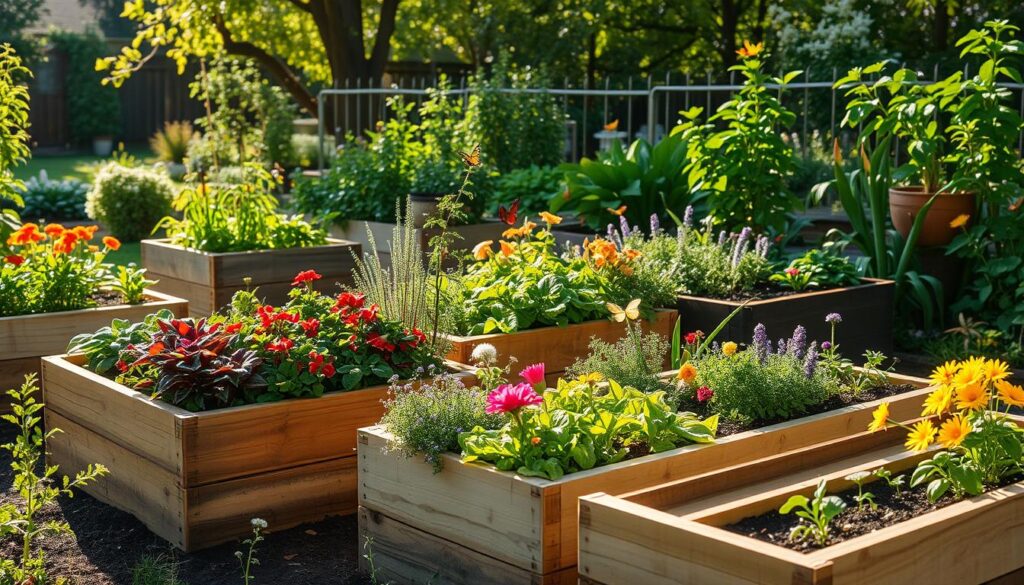
Overall, raised garden beds are a smart choice for home gardeners. They help improve DIY gardening skills and offer many benefits of raised bed gardening.
Essential Materials for Building Raised Garden Beds DIY
Choosing the right materials is key for a successful raised garden bed. The wood, soil, and other parts used impact the bed’s durability and look. For a DIY project, picking quality and compatible materials is crucial.
A good garden design considers the materials for the raised bed. Cedar, recycled plastic, and composite materials are popular. They resist rot, insects, and weathering well.
When planning your DIY project, make a list of needed materials. Here are some essentials:
- 2″ x 6″ or 2″ x 8″ lumber for the frame
- Wood screws or nails for assembly
- Weather-resistant wood glue
- Soil and compost for filling the bed
By picking the right materials and following a guide, you can make a beautiful garden. It will meet your needs and enhance your outdoor space.
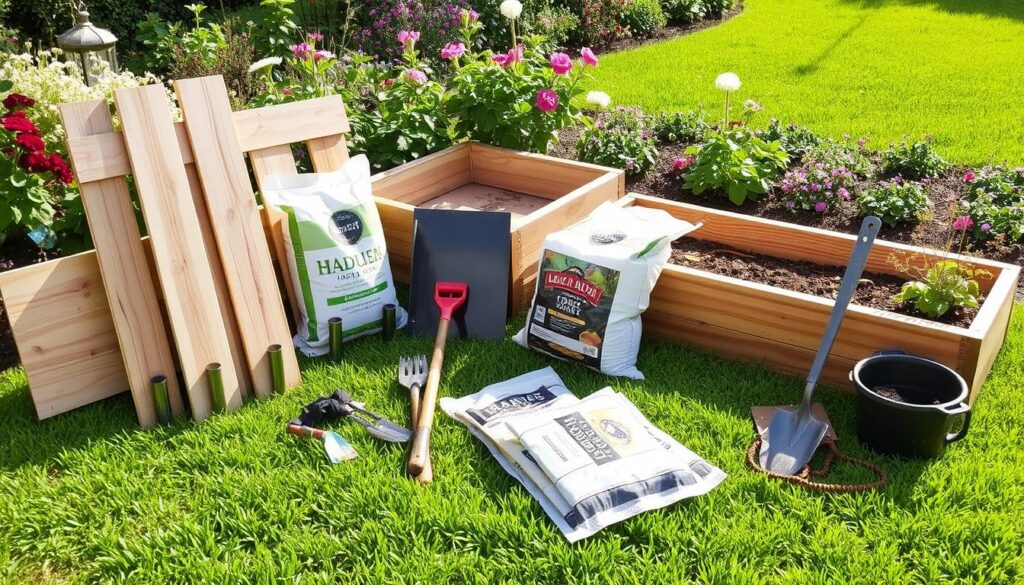
Planning Your Raised Bed Garden Layout
When planning your garden, laying out your raised bed is key. You need to think about sunlight, drainage, and how easy it is to get to. A good raised bed layout can really help your garden succeed.
First, think about how much sunlight your garden will get. Most plants need at least 6 hours of direct sunlight a day. Also, raised beds can hold water, so you might need a slight slope or a drainage system to avoid this.
Choosing the Perfect Location
When picking a spot for your raised bed, keep these things in mind:
- How close it is to water
- The amount of sunlight and shade it gets
- The quality of the soil and how well it drains
These factors will help you find the best spot for your raised bed. This ensures your plants will have what they need to grow well.
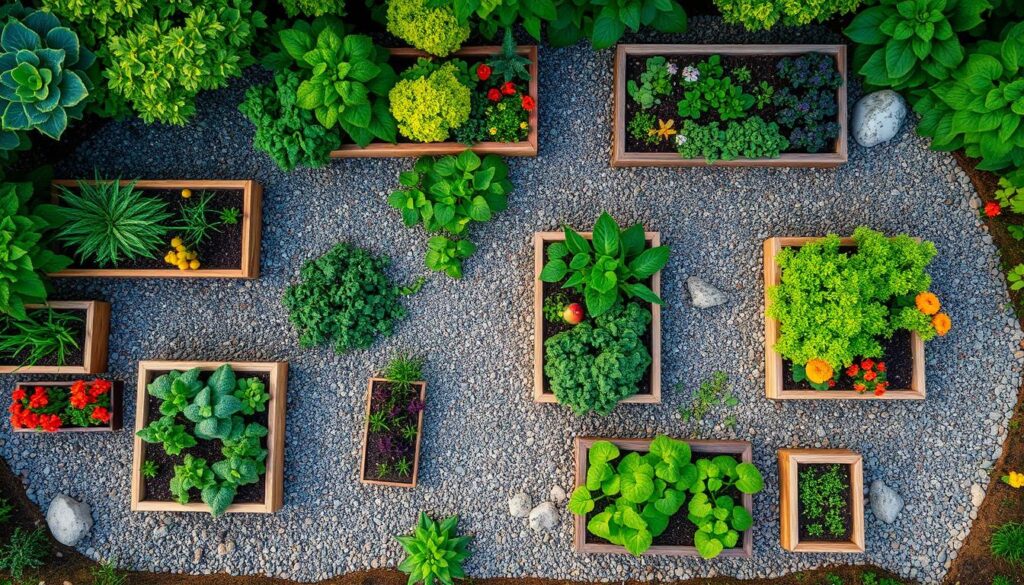
Determining Optimal Size and Height
The size and height of your raised bed depend on the space you have and the plants you want to grow. Aim for a height of 6-8 inches to help roots grow. You can also use DIY gardening to make a raised bed that fits your needs perfectly.
| Bed Size | Plant Capacity |
|---|---|
| 4×4 feet | 16-20 plants |
| 4×8 feet | 32-40 plants |
By following these tips and thinking about what you need, you can make a raised bed garden that will flourish. It will give you a great harvest.
Step-by-Step Guide to Building Raised Garden Beds
Building raised garden beds DIY is a fun and rewarding outdoor project. You only need basic garden construction skills to start. First, clear the area of any debris and level the ground. This makes a stable base for your raised garden beds.
Next, gather the materials you need, like wood, soil, and any other components. Think about using sustainable materials. Also, consider adding features like irrigation systems to make your project more efficient.

- Assemble the frame using wood screws or nails
- Line the bottom with a weed barrier to prevent unwanted growth
- Fill the bed with a mix of topsoil, compost, and other nutrients
By following these steps and using the right materials, you can create a thriving raised garden bed. It will be the centerpiece of your outdoor projects.
Remember to think about drainage and accessibility when building your raised garden beds DIY. With a little planning and creativity, you can create a beautiful and functional garden. It will bring you joy for years to come and enhance your outdoor living space.
Creative Design Ideas for Raised Garden Beds
Raised bed designs offer endless creative possibilities. You can choose from traditional wooden designs to modern metal ones. DIY projects are also a great way to add a personal touch to your garden.
Using upcycled materials like old pallets or brick can make your raised bed unique. Others might prefer a modern look with metal or composite materials. Raised bed designs can fit any garden or yard style.
Traditional Wooden Designs
Wooden designs are a classic choice for raised garden beds. You can use woods like cedar or pine. They can be stained or painted to match your outdoor decor.
Modern Metal Configurations
Modern metal configurations give raised garden beds a sleek look. They can be made from aluminum or steel. Powder-coating makes them durable.
Upcycled Material Options
Upcycled materials add a personal touch to raised garden beds. You can use old pallets, brick, or stone. This creates a unique and functional design.

Incorporating these design ideas into your garden can make it beautiful and functional. You can choose from traditional wooden designs, modern metal, or upcycled materials. There are countless ways to make your raised garden beds stand out.
| Design Style | Materials | Benefits |
|---|---|---|
| Traditional Wooden | Cedar, Pine | Classic look, durable |
| Modern Metal | Aluminum, Steel | Sleek look, low maintenance |
| Upcycled | Old pallets, brick, stone | Unique look, eco-friendly |
Soil Preparation and Filling Your Raised Beds
Proper soil preparation is key for a healthy raised garden bed. It means making a mix of garden soil that has the right nutrients, pH, and drainage. You need to think about the plants you’re growing and what soil they need.
A good raised bed filling mix has topsoil, compost, and perlite or vermiculite. This mix keeps moisture, stops weeds, and controls soil temperature. You can make your own mix or buy one from a trusted supplier.
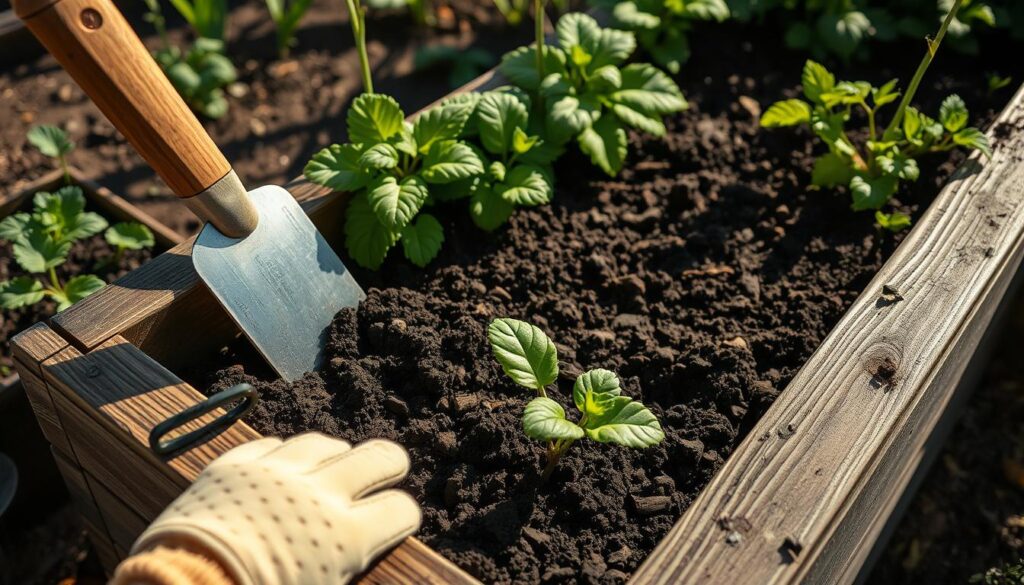
- pH balance: most plants like a slightly acidic to neutral soil pH (around 6.0-7.0)
- nutrient content: add compost or manure for essential nutrients
- drainage: use perlite or vermiculite to improve soil and prevent waterlogging
By following these tips and using the right garden soil mix, you’ll have a thriving raised garden bed. Always test your soil and adjust as needed for the best growing conditions.
Best Plants for Raised Garden Beds
Raised garden beds are great for plants to grow well. The right plants can make a big difference. Tomatoes, cucumbers, and carrots do well here because of the better soil.
Think about companion planting too. This means pairing plants that help each other grow. For example, marigolds can keep nematodes away from tomatoes. This makes your garden healthy and balanced.
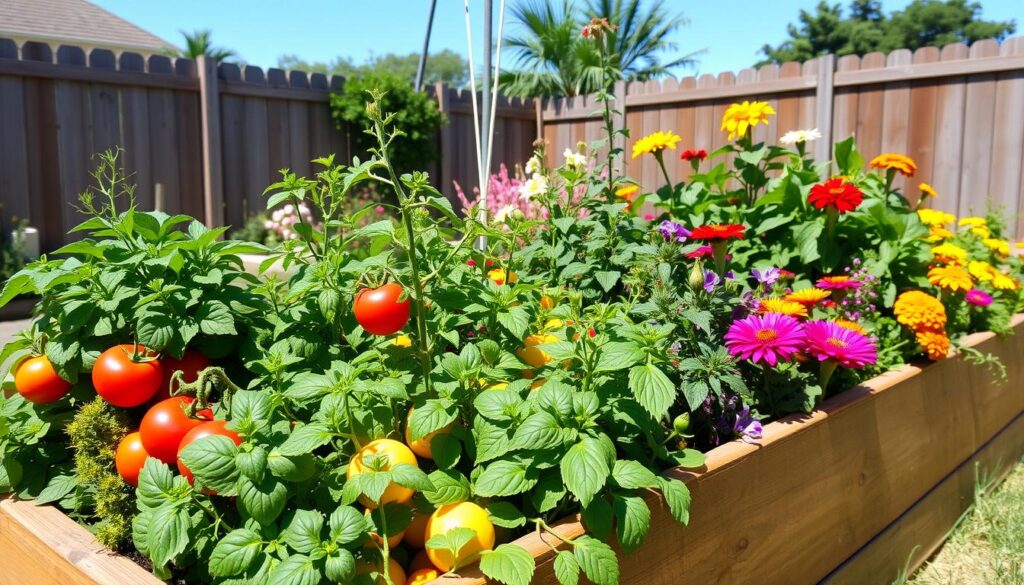
Leafy greens like lettuce and kale are also good choices. So are herbs like basil and mint. They grow fast and are easy for beginners. With the right mix, your garden will be full of fresh food all season.
Here are some tips for picking the best plants for your raised beds:
- Think about your area’s climate and soil when picking plants
- Choose plants that are easy to care for and resistant to diseases
- Plant a mix of annuals and perennials for interest all year
Irrigation and Watering Systems
Watering raised garden beds right is key for their health and growth. Garden irrigation systems save water and cut down on work. You can choose from drip systems and smart watering solutions. These fit the needs of raised bed care, giving plants the right water at the right time.
A good irrigation system cuts down on water waste and stops overwatering. Important things to think about include:
- Water conservation: Look for systems with rain and moisture sensors to adjust watering.
- Efficiency: Drip irrigation systems send water straight to plant roots, cutting down on evaporation and runoff.
- Automation: Smart watering solutions can water plants at the best times, based on weather and soil moisture.
Getting a reliable and efficient watering system means healthier plants, lower water bills, and more time to enjoy your garden.
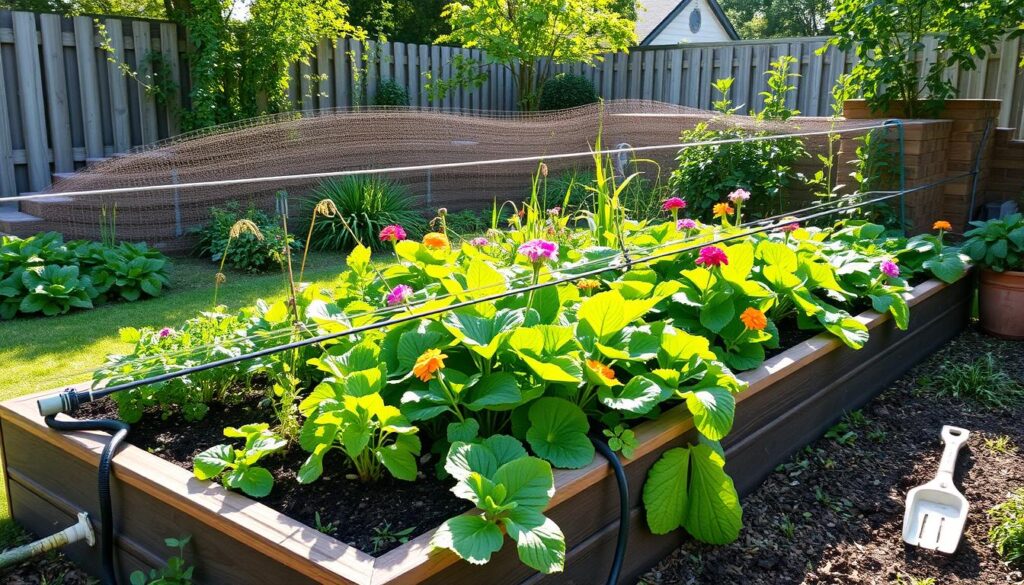
| Watering System | Benefits | Cost |
|---|---|---|
| Drip Irrigation | Water conservation, reduced labor | Moderate |
| Smart Watering Solutions | Automation, optimized watering schedules | Higher |
Year-Round Maintenance Tips
To keep your raised garden bed thriving, follow a regular garden maintenance schedule. This includes tasks like soil replenishment, pest control, and seasonal tips for planting. By doing these tasks, you’ll enjoy a healthy and productive garden all year.
Ensuring the soil is fertile and well-draining is key in raised bed care. Add organic matter like compost or manure. Use mulch and straw to retain moisture and suppress weeds. Also, watch for pests and diseases and act quickly if you see any.
Here are some seasonal tips to keep in mind:
- Spring: Plant cool-season crops like broccoli and kale. Add mulch to retain moisture and suppress weeds.
- Summer: Keep the soil moist. Provide support for plants like tomatoes and peas.
- Autumn: Harvest crops. Add compost or manure to the soil for the next season.
- Winter: Protect the soil from extreme temperatures and moisture loss. Cover it with straw or mulch.
By following these garden maintenance tips and staying on top of raised bed care, you’ll enjoy a thriving garden all year. Always follow seasonal tips and act quickly if you notice any problems with your plants.

| Season | Task | Tip |
|---|---|---|
| Spring | Plant cool-season crops | Use a mixture of mulch and straw to retain moisture and suppress weeds |
| Summer | Keep the soil consistently moist | Provide support for plants that need it, such as tomatoes and peas |
| Autumn | Harvest any remaining crops | Add a layer of compost or manure to the soil to prepare it for the next growing season |
| Winter | Protect the soil from extreme temperatures and moisture loss | Cover the soil with a layer of straw or mulch |
Common Challenges and Solutions
Raised garden beds can face several challenges that affect plant health and productivity. To tackle these issues, effective solutions are needed. One major concern is pest management, as pests can harm plants and damage the garden.
Pests like aphids, whiteflies, and spider mites can infest raised beds. To control them, gardeners can introduce beneficial insects, maintain cleanliness, and use organic pest control. Regular checks and upkeep are key to keeping pests away and ensuring the garden’s health.
Pest Management Strategies
- Introduce beneficial insects, such as ladybugs and lacewings, to control pest populations
- Practice good hygiene, including removing weeds and debris, to prevent pest infestations
- Use organic pest control products, such as neem oil and insecticidal soap, to manage pest populations
Preventing soil depletion is also vital for a healthy raised garden bed. This can be done by adding compost, mulch, and rotating crops. These steps help keep the soil fertile and structured, creating a thriving garden ecosystem.
Soil Depletion Prevention
Adding compost and mulch regularly keeps the soil fertile and structured. This reduces the need for synthetic fertilizers and prevents soil depletion. Crop rotation also helps break disease and pest cycles, promoting a balanced and diverse garden.
| Soil Amendment | Benefits |
|---|---|
| Compost | Improves soil fertility and structure |
| Mulch | Retains moisture and suppresses weeds |
| Crop Rotation | Breaks disease and pest cycles, promotes diversity |
Conclusion: Creating Your Perfect Raised Bed Garden
Building a raised garden can be fun and rewarding. This guide has shown you how to start and keep your garden growing. You’re now ready to make your dream garden a reality.
First, make a plan and pick the right materials. Then, get your soil ready. Try out different designs to find the perfect fit for your space. And, choose plants that will do well in your garden.
With some work and patience, your garden will become a lush paradise. It will give you fresh food, beautiful flowers, and a sense of pride. Enjoy every step of the way and look for more tips to make your garden even better.
FAQ
What are the main benefits of raised garden beds?
Raised garden beds offer better soil control and drainage. They also reduce back strain and make gardening easier. Plus, they can extend your growing season.
What materials are needed to build raised garden beds?
You’ll need durable wood like cedar or pressure-treated pine. Also, high-quality soil, gardening tools, and possibly screws or nails are necessary.
How do I choose the best location for my raised garden beds?
Look for a spot with lots of sunlight and good drainage. It should also be easy to reach. This ensures your plants grow well.
What is the ideal size and height for raised garden beds?
The best size and height vary based on space and your needs. Beds that are 4 to 8 feet wide and 6 to 24 inches high work well.
Can I use a variety of materials to build my raised garden beds?
Yes, you can use different materials. Options include wood, metal, and even upcycled items like pallets. Choose based on durability, sustainability, and looks.
How do I prepare the soil for my raised garden beds?
Start by testing the soil’s pH. Then, add organic matter like compost. Make sure it drains well for the best growing conditions.
What are the best plants to grow in raised garden beds?
Raised beds are great for veggies, herbs, and some ornamental plants. Tomatoes, peppers, leafy greens, carrots, and herbs are top choices. Use companion planting to boost your yields.
How do I maintain my raised garden beds year-round?
Keep up a regular routine of tasks. This includes adding soil, controlling pests, and preparing for each season. Weeding, mulching, and watering are key for healthy beds.
What are some common challenges with raised garden beds, and how can I address them?
Challenges include pests, soil loss, and structural problems. Use effective pest control, replenish soil, and maintain the structure to solve these issues.